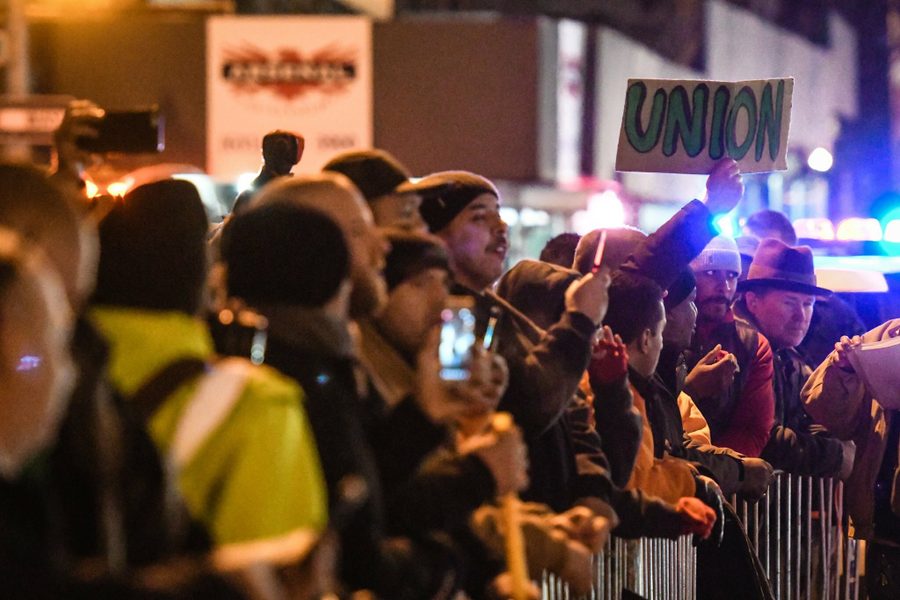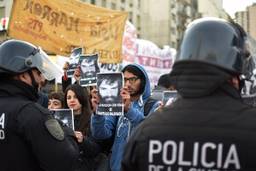These Union Members Are Going to War with the Largest Private Development Project in U.S. History
Juan Cruz Ferre

It’s 6:00 a.m. in a gelid winter morning. A crowd of sturdy bodies, mostly construction workers, packs a corner in Midtown Manhattan. The chants of, “Open shop, broken shop!” can be heard blocks away amidst the cacophony of New York City traffic.
The January 11 weekly rally — one of many continuing to the present — was held in the shadow of a structural behemoth standing at 1,296 feet and scheduled to open in 2019. Hudson Yards is the largest private development project in U.S. history. But while billions of dollars are poured into it every year, the main developer, Related, is trying to reduce costs by hiring non-union labor. Workers of all trades are standing up together to keep the jobs union.
The months-long rallies started in November and endured through the harsh winter, every Thursday morning. Now they continue into the summer, with campaign organizers staging additional rallies on Tuesday afternoons. The campaign, known on social media as #CountMeIn, originated last year in a rank-and-file effort to keep union jobs at Hudson Yards. Every so often, a massive march shakes the streets of mid-town Manhattan.
Related is refusing to sign a new Project Labor Agreement (PLA). Signing such an agreement would prohibit them from employing non-union workers and reduce the labor costs in the second phase of the project. Currently, union workers earn on average 42 percent higher wages than nonunion workers.
PLAs are deals between employers and unions for specific construction projects that override existing collective bargaining agreements. PLAs in the past few decades have typically included concessions from labor in terms of pay and work rules to compel employers to hire union workers. Unfortunately, PLAs often include a no-strike pledge, which requires labor to give up its most powerful weapon against bosses. Related has expressed through their spokesperson Joanna Rose that they “will not negotiate” with the Building and Construction Trades Council of Greater New York.
Construction boom
In times of economic downturn, employers argue that the only way to keep the shop afloat is by lowering costs, and so workers have to bear part of the burden and tighten their belts for the benefit of all. But when business thrives, only employers reap the profits.
The construction sector has seen vigorous growth after the dust from the economic crash settled. The U.S. construction industry climbed from value-added $547 billion in 2011 to $826 billion in 2017, according to the U.S. Bureau of Economic Analysis. New York City’s landscape is, indeed, a microcosm of this construction boom, with cranes and bare-bones-towers springing across the city. Between 2010 and 2016, employment in construction of buildings in New Yorkgrew almost 50 percent, from 30 to over 43 thousand registered workers.
Hudson Yards is by far the most significant private development in the city, with an estimated 4,000 construction workers employed on any given day. Expected to be completed by 2025, the entire project will have cost $25 billion. Although presented as a megaproject built on idle land, Hudson Yards needs to be contrasted with alternative projects proposed for that space.
Tom Angotti, an urban policy scholar and author of New York For Sale, told In These Times, “People in Chelsea and Hell’s Kitchen, local businesses, small businesses, got together and said ‘this is what we want the area to look like.’ They presented their vision. The city patiently listened and then went ahead and structured the Hudson Yards’ deal the way they wanted anyway.”
In January of 2005, the City Council approved the Bloomberg Administration’s plan to re-zone the far West Side of Manhattan to allow the wholesale construction of high-rise towers. Community boards, it is stipulated in the city charter, have to be consulted on development proposals like this one. “But whatever they say,” scholar David Halle at CUNY Graduate Center told In These TImes, “It’s only advisory.” According to Halle, “If they say they love it, it goes through, if they say they don’t like it, it still goes through.”
There is no doubt that this megaproject is changing the physiognomy of Manhattan’s West Side, deepening the gentrification of Chelsea and Hell’s Kitchen. Although developers made sure to include some affordable units in the project, a feature that allows them to build taller, the average cost of a regular unit is out reach for working-class people. Of the building’s 251 apartments, just 63 are affordable units. Other units, meanwhile, rent for high prices, with one-bedroom apartments priced at $5,400 a month. “None of us trades-persons can afford those apartments,” says Mark Davis, a tile setter and member of Local 7. “So, in my opinion, what they consider affordable housing is just an illusion.”
The future of labor
In February, Related filed a federal lawsuit against Mr. LaBarbera. They accused him and the unions working at Hudson Yards of corruption and violation of the labor agreement signed by both parties before starting the construction. The trades council accused Related in court of unlawful labor practices that unfairly targeted workers who supported the #CountMeIn campaign. Other lawsuits were filed against Trade Off and other companies subcontracted by Related, which had employed non-union contractors.
Workers say the real purpose behind Related’s legal attack is to sideline the Building Trades Council and negotiate with individual unions or replace union workers with non-union ones when possible. Initial works in the foundations of 55 Hudson Yards with nonunion workers sparked the outrage of union members at the very earliest stages of the development project. “If you bring someone to work side by side with us and pay him 15 bucks an hour, because that’s what you think he’s worth. And we know that we put our lives in the line day in and day out… It’s a smack in the face to us,” says Desmond Rivers, sheet metal worker at Hudson Yards. Existing frictions within the building trades may allow Related to drive a wedge between them, undermining them all.
The outcome of this battle will have lasting consequences for the labor movement in New York and beyond. In the past few decades, the building trades unions, much like most other unions, have given up concessions to allow their employers to ‘compete with nonunion’ contractors. Anger among workers, particularly among apprentices, has grown for this reason. And the rank-and-file origins of #CountMeIn clearly show that the membership is ready to fight.
The outcome of this landmark struggle may well depend on whether the unions involved can become a vehicle for advancing class struggle, and not cross-class compromise. The #CountMeIn campaign has the potential to break the decades-long decline in union membership in the building trades in New York, especially if it opens an opportunity for the active engagement of the rank and file. This means mobilizing members, but also encouraging them to discuss the next steps and take the campaign in their hands. All in all, winning this battle will likely require the undertaking of bold actions, disruptive pickets and even breaking the law or going on strike if necessary.





